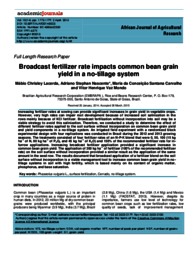Broadcast fertilizer rate impacts common bean grain yield in a no-tillage system.
Broadcast fertilizer rate impacts common bean grain yield in a no-tillage system.
Autoria: LACERDA, M. C.; NASCENTE, A. S.; CARVALHO, M. da C. S.; MONDO, V. H. V.
Resumo: Increasing fertilizer rates at sowing can provide significant increases in grain yield in vegetable crops. However, very high rates can impair root development because of increased soil salinization in the rows mainly because of KCl fertilizer. Broadcast fertilization without incorporation into soil may be a viable strategy to avoid this salinization. Therefore, we conducted a study to determine the effect of different fertilizer rates applied to the soil surface without incorporation on common bean grain yield and yield components in a no-tillage system. An irrigated field experiment with a randomized block experimental design with four replications was conducted in Brazil during the 2012 and 2013 growing seasons. The treatments consisted of four fertilizer rates of an N-P-K blend that were 0, 50, 100 (15 kg ha-1 of N, 90 kg ha-1 of P2O5 and 45 kg ha-1 of K2O) and 150% of the recommended fertilizer rate for in-furrow applications. Increasing broadcast fertilizer application provided a significant increase in common bean grain yield. The application of 300 kg ha-1 of fertilizer (100% of the recommended fertilizer rate) on the soil surface without incorporation provided a similar result as the application of the same amount in the seed row. The results document that broadcast application of a fertilizer blend on the soil surface without incorporation is a viable management tool to increase common bean grain yield in no-tillage systems in soil with high fertility, which is based mainly on its content of organic matter, phosphorus, and base saturation.
Ano de publicação: 2015
Tipo de publicação: Artigo de periódico
Unidade: Embrapa Arroz e Feijão
Palavras-chave: Broadcasters, Cerrado, Feijão, Fertilizer application, No-tillage, Phaseolus Vulgaris, Plantio direto
Observações
1 - Por padrão são exibidas publicações dos últimos 20 anos. Para encontrar publicações mais antigas, configure o filtro ano de publicação, colocando o ano a partir do qual você deseja encontrar publicações. O filtro está na coluna da esquerda na busca acima.
2 - Para ler algumas publicações da Embrapa (apenas as que estão em formato ePub), é necessário ter, no celular ou computador, um desses softwares gratuitos. Sistemas Android: Google Play Livros; IOS: iBooks; Windows e Linux: software Calibre.
Acesse outras publicações
Acesse a Base de Dados da Pesquisa Agropecuária (BDPA) para consultar o acervo completo das bibliotecas da Embrapa.

